GitHub Actions Build System
GitHub Workflows
Section titled “GitHub Workflows”This section provides templates/examples of what a GitHub Actions workflow file could look like when using CDK Express Pipeline. These examples are meant to be used as a starting point and can be customized to fit your specific needs.
These examples all assume a project created with the default structure of the CDK CLI
command cdk init app --language typescript. These templates are taken from the demo TS project: https://github.com/rehanvdm/cdk-express-pipeline-demo-ts and
can be found in the .github/workflows-manual
directory of that project.
.github/workflows/diff.yml
Does a build and CDK Diff on PR open and push, the cdk diff output can be viewed in the action run logs.
name: Diffon: pull_request: types: [ opened, synchronize ] workflow_dispatch: { }
env: FORCE_COLOR: 1
jobs: deploy: name: CDK Diff and Deploy runs-on: ubuntu-latest permissions: actions: write contents: read id-token: write steps: - name: Checkout repo uses: actions/checkout@v4
- name: Set up node uses: actions/setup-node@v3 with: node-version: 20 cache: npm
- name: Install dependencies run: npm install ci
# TODO: Alternatively use an AWS IAM user and set the credentials in GitHub Secrets (less secure than GH OIDC below) - name: Configure AWS credentials uses: aws-actions/configure-aws-credentials@v4 with: role-to-assume: # TODO: Your role to assume aws-region: # TODO: your region
- name: CDK diff run: npm run cdk -- diff '**'Produces the following output in the GitHub Action logs:
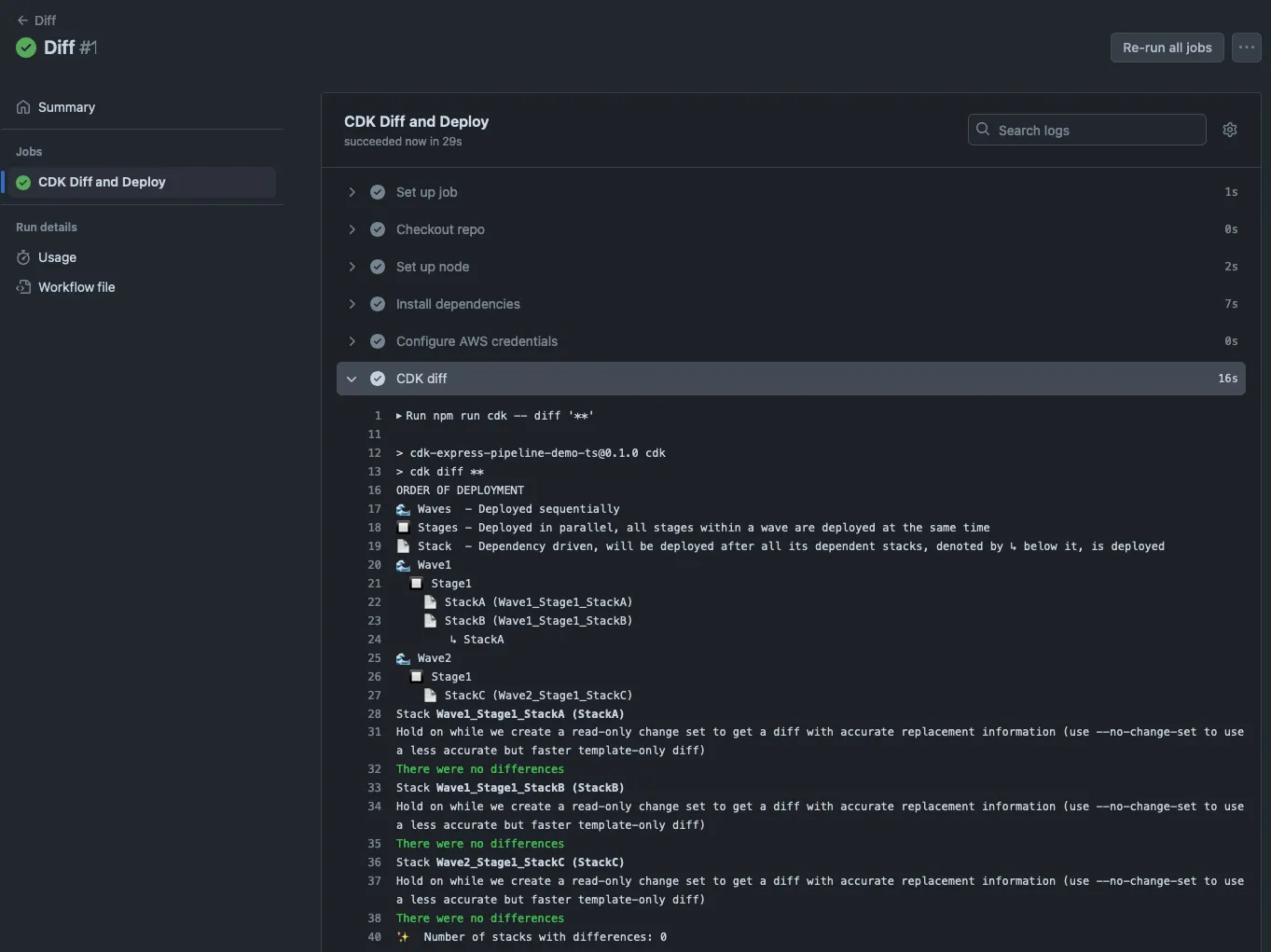
.github/workflows/deploy.yml
Does a build, CDK Diff and Deploy when a push happens on the main branch.
name: Deployon: push: branches: - main
env: FORCE_COLOR: 1
jobs: deploy: name: CDK Diff and Deploy runs-on: ubuntu-latest permissions: actions: write contents: read id-token: write steps: - name: Checkout repo uses: actions/checkout@v4
- name: Set up node uses: actions/setup-node@v3 with: node-version: 20 cache: npm
- name: Install dependencies run: npm install ci
# TODO: Alternatively use an AWS IAM user and set the credentials in GitHub Secrets (less secure than GH OIDC below) - name: Configure AWS credentials uses: aws-actions/configure-aws-credentials@v4 with: role-to-assume: # TODO: Your role to assume aws-region: # TODO: your region
- name: CDK diff run: npm run cdk -- diff '**'
- name: CDK deploy run: npm run cdk -- deploy '**' --require-approval never --concurrency 10Produces the following output in the GitHub Action logs:
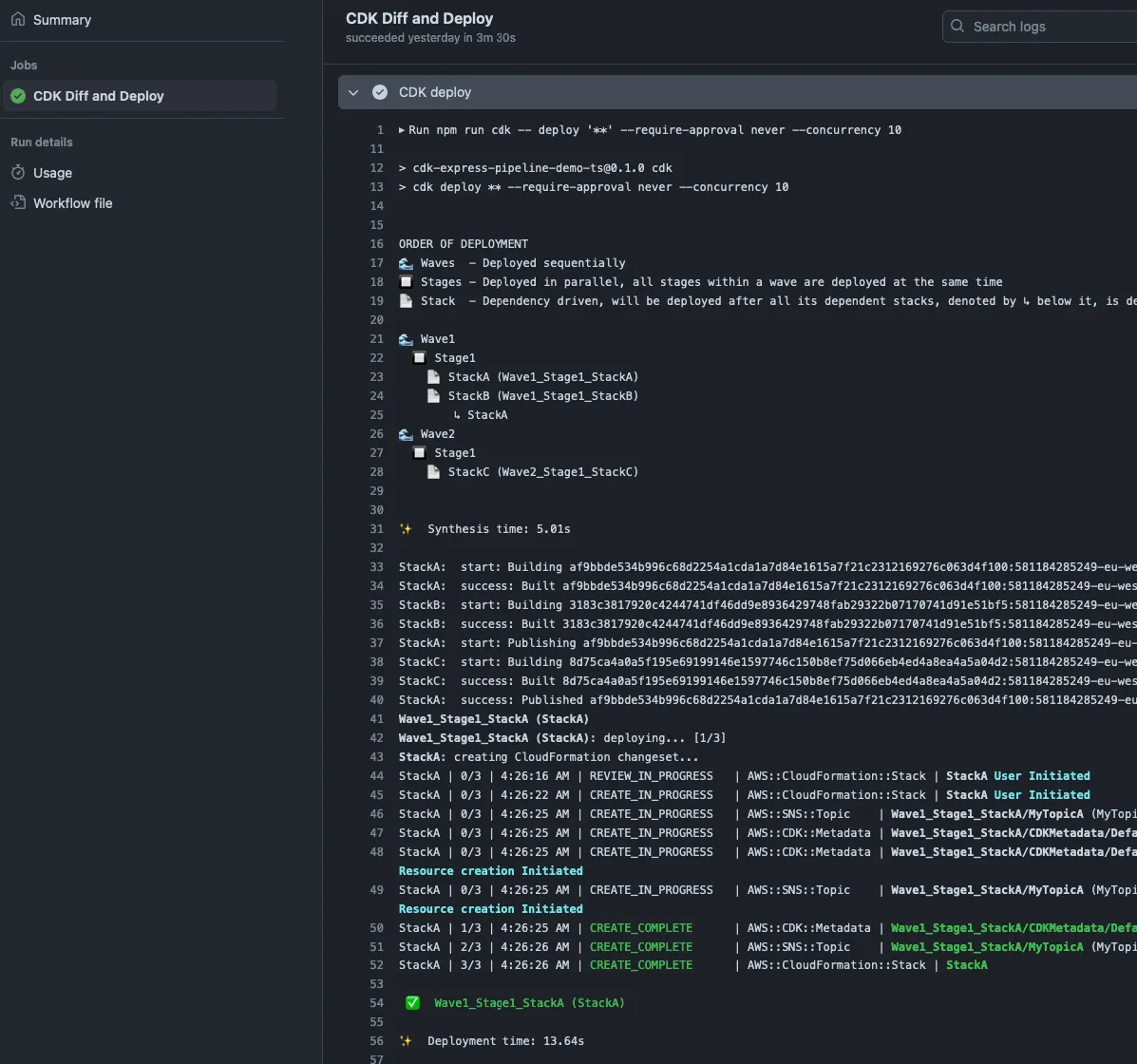
.github/workflows/deploy-advance.yml
The synth job builds the CDK app and saves the cloud assembly to the ./cloud_assembly_output directory. The whole
repo with installed NPM packages and the cloud assembly is then cached. This job of the pipeline does not have access
to any AWS Secrets, the installing of packages and building is decoupled from the deployment improving security.
The wave1 and wave2 jobs fetches the cloud assembly from the cache and then does a CDK Diff and Deploy on only their
stacks. The wave1 job targets all the stacks that start with Wave1_ and the wave2 job targets all the stacks that
start with Wave2_. It is important to add the --exclusively flag to only focus on the specified stacks and not its
dependencies.
name: Deploy Advanceon: push: branches: - main workflow_dispatch: { } # While testing only
env: FORCE_COLOR: 1
jobs: synth: name: Build and CDK Synth runs-on: ubuntu-latest permissions: actions: write
contents: read id-token: write steps: - name: Checkout repo uses: actions/checkout@v4
- name: Set up node uses: actions/setup-node@v3 with: node-version: 20 cache: npm
- name: Install dependencies run: npm install ci
- name: CDK Synth run: npm run cdk -- synth --output ./cloud_assembly_output
- name: Cache CDK Assets uses: actions/cache/save@v4 with: path: ./ key: "cdk-assets-${{ github.sha }}"
wave1: name: Wave 1 needs: - synth runs-on: ubuntu-latest permissions: actions: write contents: read id-token: write steps: - name: Fetch CDK Assets uses: actions/cache/restore@v4 with: path: ./ key: "cdk-assets-${{ github.sha }}"
- name: Configure AWS credentials uses: aws-actions/configure-aws-credentials@v4 with: role-to-assume: arn:aws:iam::581184285249:role/githuboidc-git-hub-deploy-role aws-region: eu-west-1
- name: CDK diff run: npm run cdk -- diff 'Wave1_*' --exclusively --app ./cloud_assembly_output
- name: CDK deploy run: npm run cdk -- deploy 'Wave1_*' --require-approval never --concurrency 10 --exclusively --app ./cloud_assembly_output
# Manual approval
wave2: name: Wave 2 needs: - wave1 runs-on: ubuntu-latest permissions: actions: write contents: read id-token: write steps: - name: Fetch CDK Assets uses: actions/cache/restore@v4 with: path: ./ key: "cdk-assets-${{ github.sha }}"
# TODO: Alternatively use an AWS IAM user and set the credentials in GitHub Secrets (less secure than GH OIDC below) - name: Configure AWS credentials uses: aws-actions/configure-aws-credentials@v4 with: role-to-assume: # TODO: Your role to assume aws-region: # TODO: your region
- name: CDK diff run: npm run cdk -- diff 'Wave2_*' --exclusively --app ./cloud_assembly_output
- name: CDK deploy run: npm run cdk -- deploy 'Wave2_*' --require-approval never --concurrency 10 --exclusively --app ./cloud_assembly_outputProduces the following output in the GitHub Action logs:
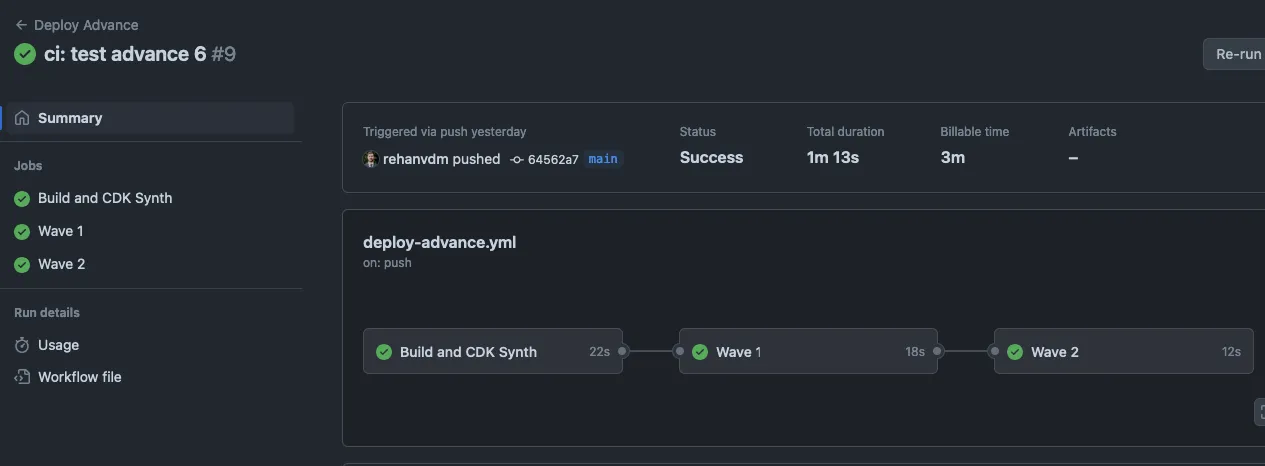
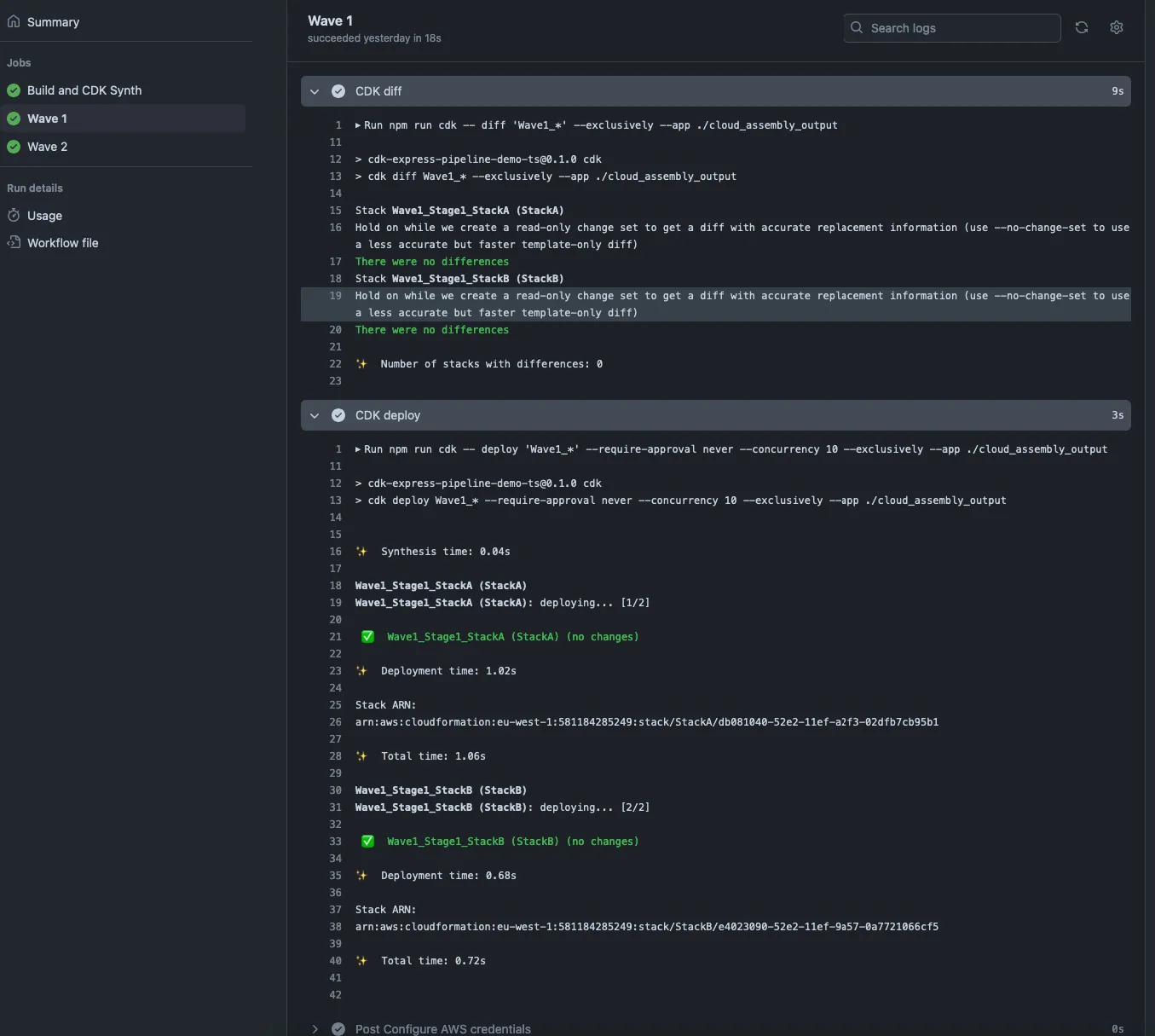
Generating GitHub Workflows
Section titled “Generating GitHub Workflows”CDK Express Pipeline includes built-in GitHub CI workflow generation that automatically create GitHub Actions workflows based on your pipeline configuration. This feature eliminates the need to manually write and maintain GitHub workflow files.
Basic Usage
Section titled “Basic Usage”To generate GitHub workflows, you need to specify a GitHubWorkflowConfig object when calling the
generateGitHubWorkflows method on your CdkExpressPipeline instance. This configuration defines how the workflows
should be structured, including build, synth, diff, and deploy commands.
This basic example assumes that you only have one environment/AWS account named prod. A CDK diff will be created on pull request
to the main branch, and a CDK deploy will be created on push action to the main branch. You can customize the
configuration to suit your needs, including multiple environments, custom build processes, and more.
import { CdkExpressPipeline, GitHubWorkflowConfig } from 'cdk-express-pipeline';
// Define your pipeline (as shown in Usage section)const app = new App();const pipeline = new CdkExpressPipeline();// ... add waves, stages, and stacks ...
// Define GitHub workflow configurationconst ghConfig: GitHubWorkflowConfig = { buildConfig: { type: 'preset-npm', // or 'workflow' to specify a GitHub workflow file for custom build process }, diff: [{ on: { pullRequest: { branches: ['main'], }, }, stackSelector: 'stage', assumeRoleArn: 'arn:aws:iam::123456789012:role/github-oidc-role', assumeRegion: 'us-east-1', commands: { prod: { synth: "npm run cdk -- synth '**'", diff: 'npm run cdk -- diff {stackSelector}', }, }, }], deploy: [{ on: { push: { branches: ['main'], }, }, stackSelector: 'stage', assumeRoleArn: 'arn:aws:iam::123456789012:role/github-oidc-role', assumeRegion: 'us-east-1', commands: { prod: { synth: "npm run cdk -- synth '**'", deploy: 'npm run cdk -- deploy {stackSelector} --concurrency 10 --require-approval never --exclusively', }, }, }],};
// Generate workflows and save them (by specifying the `true` argument)await pipeline.generateGitHubWorkflows(ghConfig, true);The workflow generation creates the following files in your .github directory:
.github/├── actions/│ ├── cdk-express-pipeline-synth/│ │ └── action.yml│ ├── cdk-express-pipeline-diff/│ │ └── action.yml│ └── cdk-express-pipeline-deploy/│ └── action.yml└── workflows/ ├── cdk-express-pipeline-diff.yml └── cdk-express-pipeline-deploy-prod.ymlConfiguration Options
Section titled “Configuration Options”Build Configuration
Section titled “Build Configuration”The buildConfig configuration defines how your CDK application is built before it is synthesized:
buildConfig: { type: 'preset-npm', // Built-in npm build process // OR type: 'workflow', workflow: { path: '.github/actions/build', // Path to custom workflow },},Specify a built-in preset (like preset-npm) which uses the standard NPM build process GitHub
Action steps, installing node and then doing npm install. Alternatively, you can specify a reusable action that defines a
custom workflow in native GitHub Actions format, allowing for a more complex build processes. Like building
assets in parallel, pushing to container registries etc. For example:
name: Custom Builddescription: Only needed if Synth build step is set to 'workflow'. When able, use the `preset-` insteadruns: using: composite steps: - name: Set up node uses: actions/setup-node@v4 with: node-version: 20 cache: npm - name: Install dependencies run: npm ci shell: bash
# Additional steps to build Applications that are referenced in the CDK appDiff Configuration
Section titled “Diff Configuration”The diff configuration defines when and how CDK diff operations are performed:
diff: [{ on: { pullRequest: { branches: ['main', 'develop'], }, // OR push: { branches: ['main'], }, }, stackSelector: 'stage', // 'wave', 'stage', or 'stack' assumeRoleArn: 'arn:aws:iam::123456789012:role/github-oidc-role', assumeRegion: 'us-east-1', commands: [ { prod: 'npm run cdk -- diff {stackSelector}' }, ],}]The on field specifies the events that trigger the diff operation, you would most likely always want to trigger this
on pull requests.
The CDK diff will be written to the PR description, this is useful for reviewing changes before merging. More info can be found in the rehanvdm/cdk-express-pipeline-github-diff GitHub action.
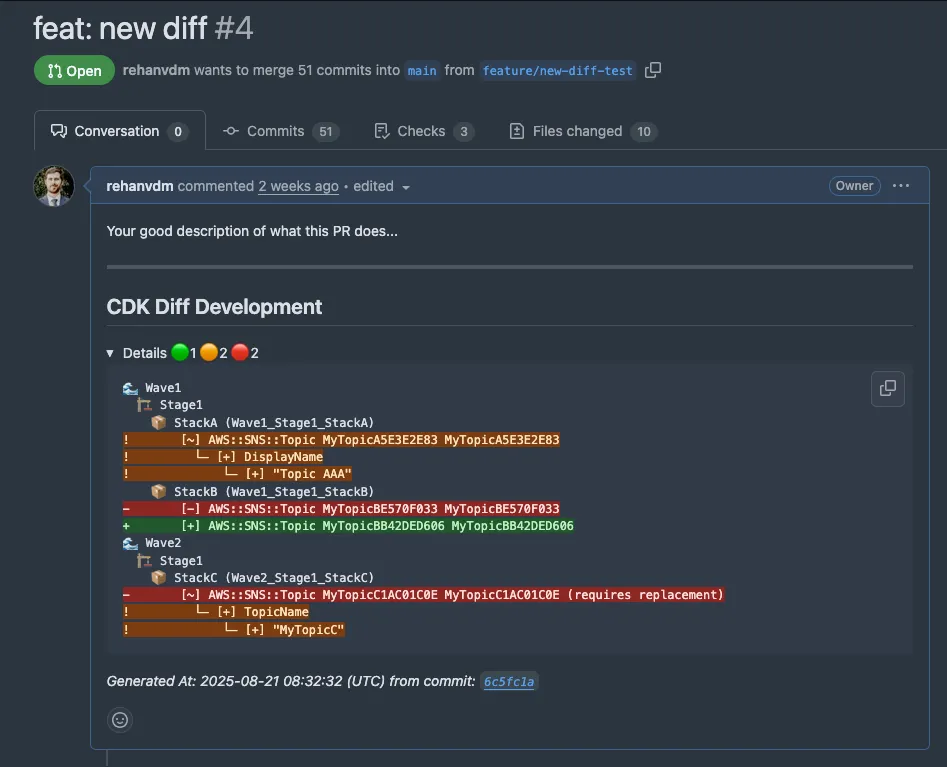
See the Stack Selectors section below for details on the stackSelector option. The assumeRoleArn
and assumeRegion options are used to configure the AWS OIDC authentication
for the GitHub Actions workflow, allowing it to assume a role in your AWS account securely when doing commands.
The commands object defines the commands to run for synthesizing and then diffing your CDK application. Specifying
both synth and diff allows you to generate multiple CDK cloud assemblies for different environments
(e.g., dev, prod) by using environment-specific commands.
This example assumes this is done with an env CDK context variable.
It shows how to generate two different cloud assemblies for dev and prod environments and store there output in
separate directories within the cdk.out directory.See Multiple Environments section
below for an example of this.
Deploy Configuration
Section titled “Deploy Configuration”The deploy configuration defines when and how CDK deploy operations are performed:
deploy: [{ on: { pullRequest: { branches: ['main'], }, }, stackSelector: 'stack', // 'wave', 'stage', or 'stack' assumeRoleArn: 'arn:aws:iam::123456789012:role/github-oidc-role', assumeRegion: 'us-east-1', commands: { prod: { synth: "npm run cdk -- synth '**'", deploy: 'npm run cdk -- deploy {stackSelector} --concurrency 10 --require-approval never --exclusively', }, },}]The on field specifies the events that trigger the deploy operation, you would most likely always want to trigger this
on pushes or on tag creation.
See the Stack Selectors section below for details on the stackSelector option. The assumeRoleArn
and assumeRegion options are used to configure the AWS OIDC authentication
for the GitHub Actions workflow, allowing it to assume a role in your AWS account securely when doing the commands.
The commands object defines the commands to run for synthesizing and then deploying your CDK application. Specifying
both synth and deploy allows you to generate multiple CDK cloud assemblies for different environments
(e.g., dev, prod) by using environment-specific commands. See Multiple Environments section
below for an example of this.
Stack Selectors
Section titled “Stack Selectors”The stackSelector option determines how stacks are targeted in diff and deploy operations:
'wave': Will create a GitHun Job in the Workflow for each wave (e.g.,Wave1_*)'stage': Will create a GitHun Job in the Workflow for each wave and stage combination (e.g.,Wave1_Stage1_*)'stack': Will create a GitHun Job in the Workflow for each wave, stage and stack combination (e.g.,Wave1_Stage1_Stack1)
The {stackSelector} placeholder in commands is automatically replaced with the appropriate pattern as shown above.
Using stack is the most granular, but it will spawn a separate job for each stack, which may not be ideal for larger
pipelines as this adds a bit of overhead. Each job needs to fetch the cdk.out (cloud assembly) and node_modules from the
cache, which can add additional time, and thus cost. This might become an issue in pipelines with large assets
and many stacks.
Recommended defaults:
diffconfig:'stage'is a good balance between granularity and performance.deployconfig:'stack'is recommended so that each job only shows the CFN deployment logs for that stack and the job can be retried if it fails without affecting other stacks.
Advanced Features
Section titled “Advanced Features”Multiple Environments
Section titled “Multiple Environments”Both diff and deploy configurations accept arrays. This allows you to define multiple workflows for different
environments or deployment strategies.
This example:
- Assumes that the
mainbranch is linked to thedevelopmentAWS environment/account and theprodbranch is linked to theproductionenvironment. - Does both
stagingandproductiondiffs on PRs to themainbranch. So that we can also see the changes that will be deployed to production when making this PR to staging. - Does a
productiondiff on PRs to theproductionbranch. - Defines separate deploy workflows for
developmentandproductionwhen pushing to themainandproductionbranches, respectively.
const ghConfig: GitHubWorkflowConfig = { buildConfig: { type: 'preset-npm', }, diff: [ { id: 'development', on: { pullRequest: { branches: ['main'], }, }, stackSelector: 'stage', assumeRoleArn: 'arn:aws:iam::123456789012:role/github-oidc-role', assumeRegion: 'us-east-1', commands: { development: { synth: "npm run cdk -- synth '**' -c env=development --output=cdk.out/development", diff: 'npm run cdk -- diff {stackSelector} --app=cdk.out/development', }, production: { synth: "npm run cdk -- synth '**' -c env=production --output=cdk.out/production", diff: 'npm run cdk -- diff {stackSelector} --app=cdk.out/production', }, }, }, { id: 'production', on: { pullRequest: { branches: ['production'], }, }, stackSelector: 'stage', assumeRoleArn: 'arn:aws:iam::123456789012:role/github-oidc-role', assumeRegion: 'us-east-1', commands: { production: { synth: "npm run cdk -- synth '**' -c env=production --output=cdk.out/production", diff: 'npm run cdk -- diff {stackSelector} --app=cdk.out/production', }, }, }, ], deploy: [ { id: 'development', on: { push: { branches: ['main'], }, }, stackSelector: 'stack', assumeRoleArn: 'arn:aws:iam::123456789012:role/github-oidc-role', assumeRegion: 'us-east-1', commands: { development: { synth: "npm run cdk -- synth '**' -c env=development --output=cdk.out/development", deploy: 'npm run cdk -- deploy {stackSelector} --app=cdk.out/development --concurrency 10 --require-approval never --exclusively', }, }, }, { id: 'production', on: { push: { branches: ['production'], }, }, stackSelector: 'stack', assumeRoleArn: 'arn:aws:iam::123456789012:role/github-oidc-role', assumeRegion: 'us-east-1', commands: { production: { synth: "npm run cdk -- synth '**' -c env=production --output=cdk.out/production", deploy: 'npm run cdk -- deploy {stackSelector} --app=cdk.out/production --concurrency 10 --require-approval never --exclusively', }, }, }, ],}The ids for the diff and deploy objects are used to generate unique workflow file names in the
.github/workflows directory. For example, these files will be generated (along with the reusable actions in the
.github/actions directory):
.github/├── actions/│ ├── cdk-express-pipeline-synth/│ │ └── action.yml│ ├── cdk-express-pipeline-diff/│ │ └── action.yml│ └── cdk-express-pipeline-deploy/│ └── action.yml└── workflows/ ├── cdk-express-pipeline-diff-development.yml ├── cdk-express-pipeline-diff-production.yml ├── cdk-express-pipeline-deploy-development.yml └── cdk-express-pipeline-deploy-production.ymlCustomization (Escape hatches)
Section titled “Customization (Escape hatches)”The generated workflows can be customized using JSON Patch operations:
import { CdkExpressPipeline, GitHubWorkflowConfig } from 'cdk-express-pipeline';
// Define your pipeline (as shown in Usage section)const app = new App();const pipeline = new CdkExpressPipeline();// ... add waves, stages, and stacks ...
// Define GitHub workflow configurationconst ghConfig: GitHubWorkflowConfig = { ...};
const ghWorkflows = await pipeline.generateGitHubWorkflows(ghConfig, false);for (let w = 0; w < ghWorkflows.length; w++) { if (ghWorkflows[w].fileName === 'workflows/cdk-express-pipeline-deploy-dev.yml') { ghWorkflows[w]?.content.patch( // Change the concurrency of the deploy dev workflow JsonPatch.replace('/concurrency/cancel-in-progress', true), //Add an extra step to the build job that echos success JsonPatch.add('/jobs/build/steps/-', { name: 'Echo Success', shell: 'bash', run: 'echo "Build succeeded!"', }), ); }}
pipeline.saveGitHubWorkflows(ghWorkflows);The JSON object of the workflow can be modified using the JsonPatch class, which provides the following methods:
add(path, value): Adds a value to an object or inserts it into an array. In the case of an array, the value is inserted before the given index. The-character can be used instead of an index to insert at the end of an array. Ex:JsonPatch.add('/milk', true) JsonPatch.add('/biscuits/1', { "name": "Ginger Nut" })remove(path): Removes a value from an object or array. Ex:JsonPatch.remove('/biscuits') JsonPatch.remove('/biscuits/0')replace(path, value): Replaces a value. Equivalent to a “remove” followed by an “add”. Ex:JsonPatch.replace('/biscuits/0/name', 'Chocolate Digestive')copy(from, path): Copies a value from one location to another within the JSON document. Both from and path are JSON Pointers. Ex:JsonPatch.copy('/biscuits/0', '/best_biscuit')move(from, path): Moves a value from one location to the other. Both from and path are JSON Pointers. Ex:JsonPatch.move('/biscuits', '/cookies')test(path, value): Tests that the specified value is set in the document. If the test fails, then the patch as a whole should not apply. Ex:JsonPatch.test('/best_biscuit/name', 'Choco Leibniz')